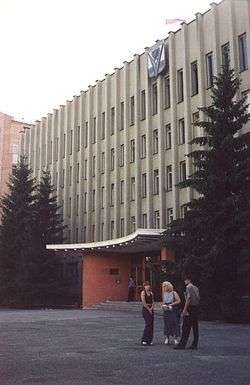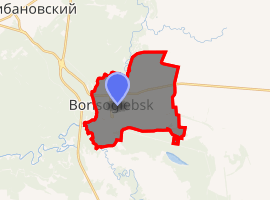Borisoglebsk
Borisoglebsk (Russian: Борисогле́бск) is a town in Voronezh Oblast, Russia, located on the left bank of the Vorona River near its confluence with the Khopyor. Population: 65,585 (2010 Census);[3] 69,392 (2002 Census);[8] 72,338 (1989 Census);[9] 65,000 (1969).
Borisoglebsk Борисоглебск | |
|---|---|
Town[1] | |
 Borisoglebsk Town Administration building | |
.png) Flag .png) Coat of arms | |
Location of Borisoglebsk 
| |
 Borisoglebsk Location of Borisoglebsk .svg.png) Borisoglebsk Borisoglebsk (Voronezh Oblast) | |
| Coordinates: 51°22′N 42°05′E | |
| Country | Russia |
| Federal subject | Voronezh Oblast[1] |
| Founded | 1646[2] |
| Government | |
| • Head | Alexey Kabargin |
| Elevation | 100 m (300 ft) |
| Population | |
| • Total | 65,585 |
| • Estimate (2018)[4] | 61,765 (-5.8%) |
| • Rank | 240th in 2010 |
| • Subordinated to | Borisoglebsky Urban Okrug[1] |
| • Capital of | Borisoglebsky Urban Okrug[1] |
| • Urban okrug | Borisoglebsky Urban Okrug[5] |
| • Capital of | Borisoglebsky Urban Okrug[5] |
| Time zone | UTC+3 (MSK |
| Postal code(s)[7] | 397160, 397163–397167, 397170–397172, 397189 |
| Dialing code(s) | +7 47354 |
| OKTMO ID | 20710000001 |
| Website | web |
History
Borisoglebsk was founded in 1646 and was named for the Russian saints Boris and Gleb, the first saints canonized in Kievan Rus' after the Christianization of the country.[2]
In the late 19th century and the early 20th century Borisoglebsk developed into a busy inland port due to its geographic location within the highly fertile Central Black Earth Region. Barges transported good such as grain, timber, kerosene, fish, eggs, watermelon from the region to large cities in western and central Russia connected to Borisoglebsk by waterways such as St. Petersburg, Moscow, Rostov, Taganrog, and Tsaritsyn. In 1870, a brewer plant opened in the town, producing dark beer and light beer, as well as fruit soda. The brewery has survived and continues to produce beer. According to the 1885 census, the population of Borisoglebsk featured 13,007 inhabitants (6,325 males and 6,682 females), almost exclusively Russian Orthodox. In the early 20th century there was a mixed-sex gymnasium in the town, with 4 female classes and 6 male classes, and a technical railway school.
In January 1906, revolutionary Maria Spiridonova assassinated G. N. Luzhenovsky at the Borisoglebsk railway station. After the Bolsheviks came to power in Borisoglebsk in 1918, one of the first concentration camps in Russia for "alien and petty-bourgeois elements" was organized in the town. In December 1922, Borisoglebsk was created 2nd Military School Red Air Force pilots which became later, the renowned Borisoglebsk Higher Military Order of the Red Banner of Lenin School for Pilots Chkalov.
Administrative and municipal status
Within the framework of administrative divisions, it is, together with twenty-four rural localities, incorporated as Borisoglebsky Urban Okrug—an administrative unit with the status equal to that of the districts.[1] As a municipal division, this administrative unit also has urban okrug status.[5]
Military
The town is host to Borisoglebsk air base.
Notable people
- Ivan Fioletov, Bolshevik revolutionary and one of the 26 Baku Commissars.
- Mitrofan Nedelin, military commander and Chief Marshal of the Artillery, namesake of the Nedelin catastrophe.
Twin town
References
Notes
| Wikisource has the text of the 1911 Encyclopædia Britannica article Borisoglyebsk. |
- Law #87-OZ
- Энциклопедия Города России. Moscow: Большая Российская Энциклопедия. 2003. p. 52. ISBN 5-7107-7399-9.
- Russian Federal State Statistics Service (2011). "Всероссийская перепись населения 2010 года. Том 1" [2010 All-Russian Population Census, vol. 1]. Всероссийская перепись населения 2010 года [2010 All-Russia Population Census] (in Russian). Federal State Statistics Service.
- "26. Численность постоянного населения Российской Федерации по муниципальным образованиям на 1 января 2018 года". Federal State Statistics Service. Retrieved January 23, 2019.
- Law #63-OZ
- "Об исчислении времени". Официальный интернет-портал правовой информации (in Russian). June 3, 2011. Retrieved January 19, 2019.
- Почта России. Информационно-вычислительный центр ОАСУ РПО. (Russian Post). Поиск объектов почтовой связи (Postal Objects Search) (in Russian)
- Russian Federal State Statistics Service (May 21, 2004). "Численность населения России, субъектов Российской Федерации в составе федеральных округов, районов, городских поселений, сельских населённых пунктов – районных центров и сельских населённых пунктов с населением 3 тысячи и более человек" [Population of Russia, Its Federal Districts, Federal Subjects, Districts, Urban Localities, Rural Localities—Administrative Centers, and Rural Localities with Population of Over 3,000] (XLS). Всероссийская перепись населения 2002 года [All-Russia Population Census of 2002] (in Russian).
- "Всесоюзная перепись населения 1989 г. Численность наличного населения союзных и автономных республик, автономных областей и округов, краёв, областей, районов, городских поселений и сёл-райцентров" [All Union Population Census of 1989: Present Population of Union and Autonomous Republics, Autonomous Oblasts and Okrugs, Krais, Oblasts, Districts, Urban Settlements, and Villages Serving as District Administrative Centers]. Всесоюзная перепись населения 1989 года [All-Union Population Census of 1989] (in Russian). Институт демографии Национального исследовательского университета: Высшая школа экономики [Institute of Demography at the National Research University: Higher School of Economics]. 1989 – via Demoscope Weekly.
Sources
- Воронежская областная Дума. Закон №87-ОЗ от 27 октября 2006 г. «Об административно-территориальном устройстве Воронежской области и порядке его изменения», в ред. Закона №41-ОЗ от 13 апреля 2015 г. «О внесении изменений в Закон Воронежской области "Об административно-территориальном устройстве Воронежской области и порядке его изменения"». Вступил в силу по истечении 10 дней со дня официального опубликования. Опубликован: "Молодой коммунар", №123, 3 ноября 2006 г. (Voronezh Oblast Duma. Law #87-OZ of October 27, 2006 On the Administrative-Territorial Structure of Voronezh Oblast and on the Procedures of Changing It, as amended by the Law #41-OZ of April 13, 2015 On Amending the Law of Voronezh Oblast "On the Administrative-Territorial Structure of Voronezh Oblast and on the Procedures of Changing It". Effective as of after 10 days from the day of the official publication.).
- Воронежская областная Дума. Закон №63-ОЗ от 15 октября 2004 г. «Об определении границ, наделении соответствующим статусом, определении административных центров отдельных муниципальных образований Воронежской области», в ред. Закона №77-ОЗ от 4 июня 2015 г. «О внесении изменений в отдельные законодательные акты Воронежской области в связи с изменением границ некоторых муниципальных образований Воронежской области». Вступил в силу со дня официального опубликования. Опубликован: "Коммуна", №166, 26 октября 2004 г. (Voronezh Oblast Duma. Law #63-OZ of October 15, 2004 On Establishing the Borders, Granting Appropriate Status, Establishing the Administrative Centers of Various Municipal Formations of Voronezh Oblast, as amended by the Law #77-OZ of June 4, 2015 On Amending Various Legislative Acts of Voronezh Oblast Due to Changing the Borders of Several Municipal Formations in Voronezh Oblast. Effective as of the official publication date.).